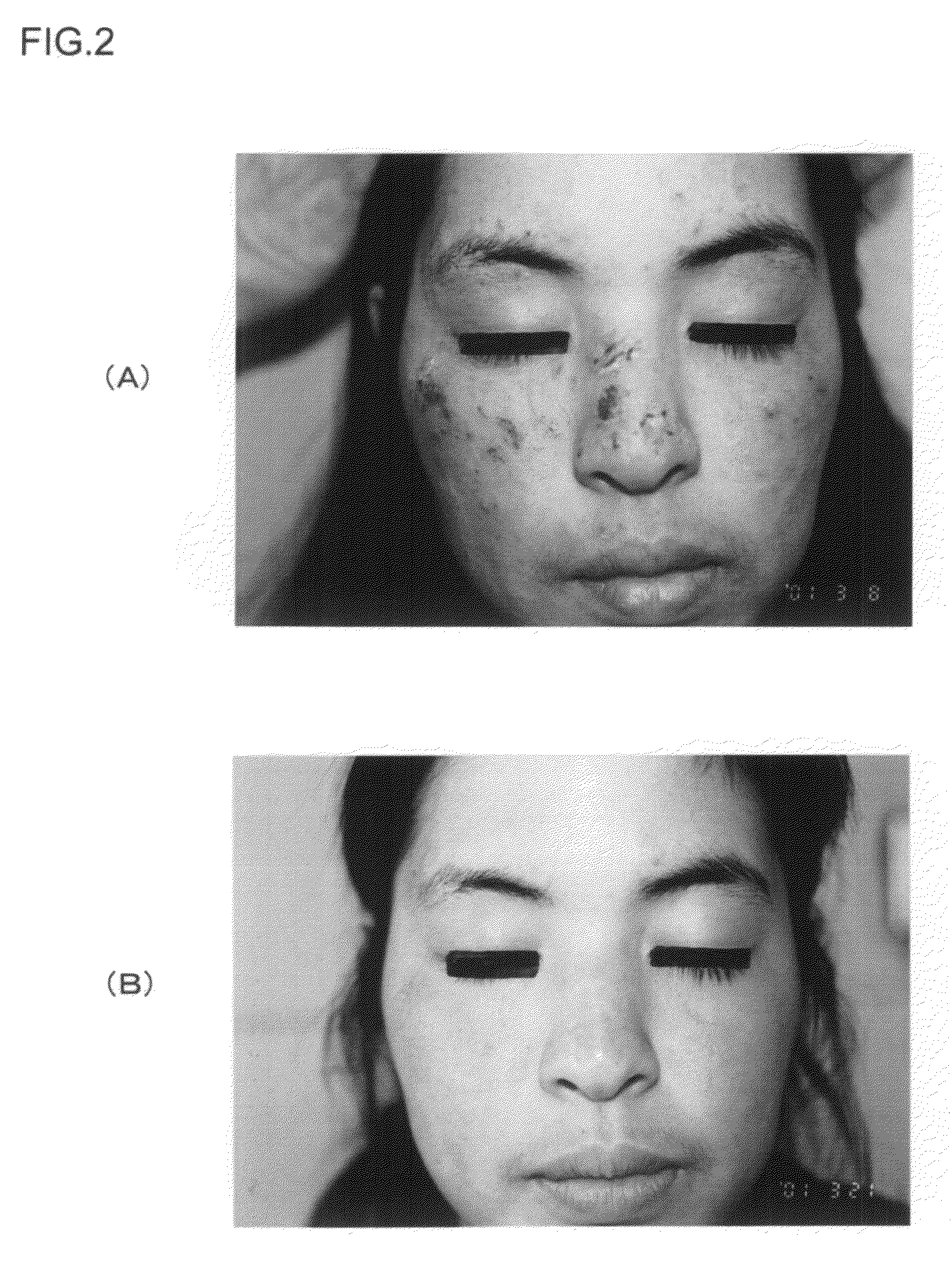Tea for treating dermatitis comprising herbal extracts
a technology of herbal extracts and tea, which is applied in the direction of immunologic disorders, drug compositions, biocides, etc., can solve the problems of increasing irritation on the skin, affecting the treatment effect, and accompanied by intense itching with wetting and erosion of patients, so as to improve physical constitution, facilitate carrying and taking, and improve the effect of treatmen
- Summary
- Abstract
- Description
- Claims
- Application Information
AI Technical Summary
Benefits of technology
Problems solved by technology
Method used
Image
Examples
case 1
[CASE 1]
Patient
[0128]Distinction of sex: Female
[0129]Date of birth: Jan. 28, 1971 (Showa 46)
[0130]Age at initial consultation: 28 years old[0131]Initial consultation: Apr. 12, 1999 (Heisei 11)[0132]Medical history: Onset of atopy was 6 years ago. No improvement was observed after use of steroidal agent for 6 years.[0133]Physical examination: Both hands are reddish and tumefacient; swollen.[0134]Prescription: Drinking of 6 g per day of the drinkable tea.[0135]Consequence: After 1 month, the effect gradually appeared; after 2 months, almost complete cure; the drinkable tea was taken 3 times a day after passage of 2 months and is now on.
FIG. 1 (A) is a photograph showing the condition of the both hands at the initial consultation; FIG. 1 (B) is a photograph showing the condition of the both hands on June 21, when 2 months and 9 days were passed after starting the treatment.
case 2
[CASE 2]
Patient
[0136]Distinction of sex: Female
[0137]Date of birth: Jan. 7, 1975 (Showa 50)
[0138]Age at initial consultation: 23 years old[0139]Initial consultation: Mar. 8, 2001 (Heisei 13)[0140]Medical history: Onset of atopy was at about elementary school girl age. No improvement was observed on use of steroidal agent. Two years ago, aggravation was found after delivery; exanthema and flare were found on all of face, extermities and trunk.[0141]Physical examination: Exanthema, flare, regional erosion, strong itch and burn were found on face. Skin of both hands is reddish, tumefacient and cracked. Lichenification was found locally.[0142]Prescription: Internal: Drinking of 3 g per day of the drinkable tea.[0143]External: Application of 3 times a day of atopic lotion A and atopic cream A on the diseased part.[0144]Consequence: After 3 weeks, eczema, flare, erosion, cracking and so on were almost completely cured; significant inprovement of itching was found.
FIG. 2 (A) is a photograp...
case 4
[CASE 4]
Patient
[0155]Distinction of sex: Male
[0156]Date of birth: Jan. 21, 1976 (Showa 51)
[0157]Age at initial consultation: 22 years old[0158]Initial consultation: Dec. 11, 1998 (Heisei 10)[0159]Medical history: Onset of atopy was at middle school boy age; gradual aggravation occurred during university student age; no improvement was observed by use of steroidal agent.[0160]Physical examination: Flare and eczema on face and head; dry and rough. Severe eczema on both hands; strong erosion, pus, itching and burn.[0161]Prescription: Internal: Drinking of 3 g per day of the drinkable tea.[0162]External: Application of 3 times a day of atopic lotion B and atopic cream B on diseased part.[0163]Consequence: after 3 weeks, eczema on both hands was almost completely cured. Improving effect was observed in symptoms on face and head.
FIG. 5 (A) is a photograph showing the condition of the fingers of the right hand at the initial consultation; FIG. 5 (B) is a photograph showing the condition of...
PUM
 Login to View More
Login to View More Abstract
Description
Claims
Application Information
 Login to View More
Login to View More - R&D
- Intellectual Property
- Life Sciences
- Materials
- Tech Scout
- Unparalleled Data Quality
- Higher Quality Content
- 60% Fewer Hallucinations
Browse by: Latest US Patents, China's latest patents, Technical Efficacy Thesaurus, Application Domain, Technology Topic, Popular Technical Reports.
© 2025 PatSnap. All rights reserved.Legal|Privacy policy|Modern Slavery Act Transparency Statement|Sitemap|About US| Contact US: help@patsnap.com



